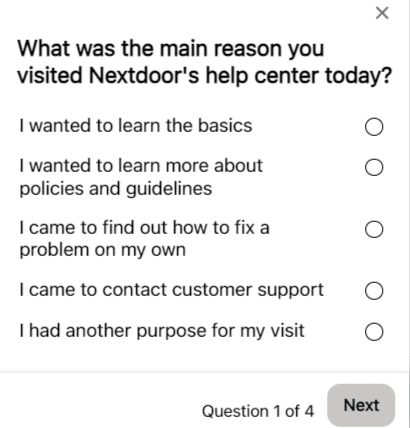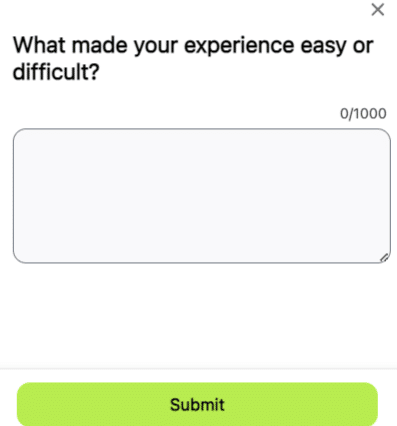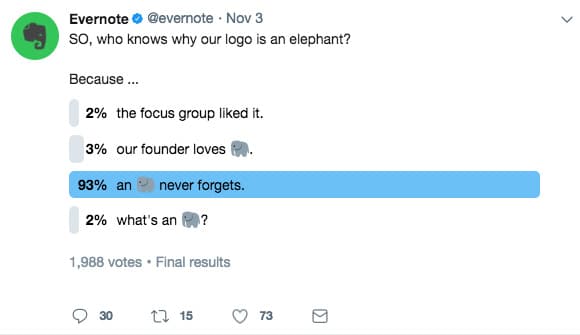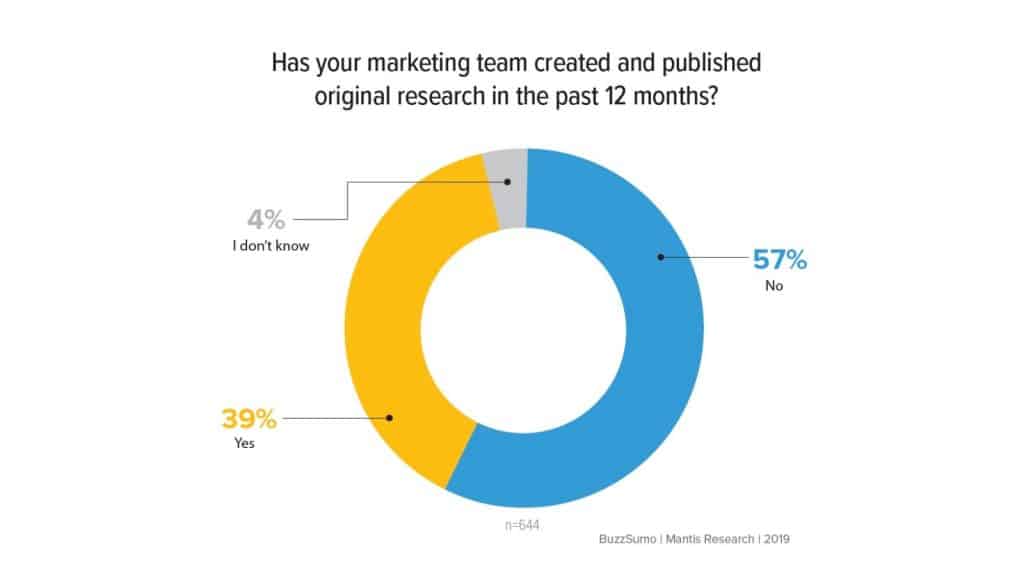How to turn polls and surveys into great content
Want to know what your customers need and want from your content?
Ask them. Then use that information to get creating.
But don’t just ask one person. Ask many. Pull from the power of the crowd.
To do that, consider creating polls and surveys – and then use the information you glean from them to create great content.
Here’s why and how.
Why polls and surveys are valuable information sources for content marketing
First, why should you conduct polls and surveys? They take a bit of planning and work to set up – so why should you bother when you can just look at your analytics or gather statistics from other sources?
Because there are some things you can only learn with these types of research.
Get deeper audience insights
At its core, your content marketing is only as good as your knowledge of your audience.
If you know them, understand them, and can root out their deep pains, challenges, and dreams, you can create content that speaks to them personally and hits them in the heart.
You’ll be able to give them unmatched value in content because your content will be tailor-made for them.
The question is, how do you unearth those kinds of insights about your audience? How do you get to understand them deeply?
There’s no better way than asking them directly. And polls and surveys let you do that on a scale magnified by 100, 1,000, or even 10,000, depending on your audience size and your brand reach.
Learn why instead of just what
You can get a lot of information on what your audience is doing by looking at your site analytics, conversion rates, and website traffic.
But often, what’s more important to understand is why they’re behaving a certain way. And statistics can’t tell you that. For instance:
- Why does our audience resonate with this topic but not that one?
- What pain points are we not solving for them?
- What types of information do they rely on us to provide – and what makes them look elsewhere?
- What’s their biggest challenge in our industry?
- What ultimate goals do our audience want to achieve?
Polls and surveys can enlighten you about all of these things in a scalable way.
Get insights unique to your business and audience
No two brand audiences are exactly alike.
Sure, they can be similar or overlapping. But ultimately, your audience is unique to your business because (hopefully) your business provides a unique solution in your market that attracts specific people.
That means if you rely on other sources to gather data and insights about your audience, those insights won’t be totally accurate or authentic.
If you want to truly understand your audience, you need to open up communication with them and learn from them directly about who they are and what they want.
Polls and surveys help you do that.
4 tips for creating polls and surveys that yield useful data
Not all polls and surveys are enlightening. To get good information, you need a well-crafted instrument.
1. Know the differences between polls and surveys – and the right time to use each
Polls and surveys are fundamentally different, and employing one over the other will give you vastly different insights.
Polls are quick, involve a single question, and include a select set of pre-written answers. All the poll-taker has to do is choose the answer they agree with most, that sounds most like them, or that fits their preferences.
As such, polls are great for feeling out the general sentiment of your audience. You’ll get a bird’s eye view of the majority opinion with a good poll.
Here’s an example of the simplest poll imaginable. It appears at the end of a blog post and asks the reader whether what they just read was helpful or not:

In contrast, surveys are more detailed and open-ended. They may include one or dozens of questions about one or many topics.
Surveys often include multiple question types: yes/no, short answer, multiple choice, ranking, etc.
This makes surveys great for getting opinions, collecting insights, measuring your audience’s preferences, and understanding their underlying motivations.
Here’s another example from Nextdoor asking for feedback on their help center experience with a short, four-question survey:

Note that the first question looks a lot like a poll. However, because there are multiple questions and question types, including an open-ended one, this is definitely a survey.

To sum up:
- Use polls to get a quick understanding of your audience’s overall sentiment about a specific question or topic.
- Use surveys to dig deeper into their motivations, preferences, and opinions.
2. Use polls and surveys formally or informally
You don’t have to use a special tool to create a poll or survey.
If you need in-depth insights on a deep topic, definitely use a tool and create a formal survey.
However, if you just want to get a general idea of how people feel about something, create an informal, spur-of-the-moment poll or survey. You don’t have to use a tool for this:
- Ask your followers an open-ended question on social media, or open up a topic for discussion in the comments. Analyze the responses.
- Create a quick social media poll on Facebook or Twitter.
- At the end of your email newsletter, ask for replies and feedback to a specific question.
Don’t forget, you can also create quick polls just to engage with your audience and for no other reason. This is an easy but fun way to add to your social media calendar.

3. Set a goal for your poll/survey
What are you ultimately hoping to learn from your poll/survey? What’s the bit of knowledge at the heart of it all that you’re trying to find out?
Similarly, what’s the main assumption you’re trying to prove correct – or disprove?
This is your goal. Especially for surveys, if you have a clear goal before creating one, you’re bound to get better results and stronger insights.
4. Ask the right questions
There’s an art to writing and formulating survey questions.
The way you phrase a question can completely change the type of answers you’ll get.
For example, take these two questions. They both ask for an opinion on essentially the same thing but will elicit completely different responses:
- Open-ended question (literally any answer is possible): What do you think of our content?
- Closed question (the possible responses are narrowed): Overall, how helpful do you find the content on our blog? Rate from 1-10.
Now, there’s a time and a place for open-ended questions. Various answers and opinions can be enlightening – as long as you have the time and resources to sift through them all.
Generally, if you want to keep things simple and easy to sort/analyze, ask closed questions with only a select number of possible answers.
Here is a great guide to writing useful survey questions that will give you clear, unbiased answers.
Get the daily newsletter search marketers rely on.
See terms.
How to use the information gleaned from polls and surveys to create great content
Now, how do you use polls and surveys to inform content creation?
In a nutshell: Use polls and surveys to directly ask a large chunk of your audience what they want from your content. Doing this in various ways will yield lots of topic ideas.
Finally, don’t forget that your survey itself could be the star of your next content piece.
Let’s break it all down.
Find out what topic is the most interesting
This is one of the quickest and easiest ways to use polls to create content.
Let’s say you’re stuck deciding between three different topics for your next blog post. You’re not sure which one your audience will be interested in most.
So, ask them! Set up a quick poll and let your audience vote on the topic they’d be most interested in. The winner is the one you’ll write about next.
Plus, you can use this knowledge to inform more content topics later. Are there any related topics to address? Your audience would probably find these interesting, too.
Discover your audience’s most pressing challenges and address them in your content
Deep audience insights about their toughest obstacles can be great fodder for content.
For example, a survey can help you pinpoint the biggest challenges they face that relate to your business or what you sell. These challenges can be broken down into smaller chunks and addressed with content.
Imagine you’re a business consultant and identify that your audience struggles with business planning. You could break that topic into smaller chunks, each a topic for a blog post (start-up costs, researching the market, figuring out licenses and registration, setting up bookkeeping, etc.).
You could also create an ultimate guide to business planning and go through all the details while linking to your sub-topic pieces.
Your audience’s pain points are a great starting place for brainstorming content topics. Surveys are the answer to find those pains and hear them described in your audience’s own words.
Gather keywords for content from their responses
This is one of the perks of including open-ended questions in your surveys (and generally asking for feedback):
You’ll get written responses in your audience’s own words, with terms and key phrases they regularly use in their vocabulary when discussing your industry.
These are gold mines for keywords.
- Look for repeated phrases that have significance to the larger topic.
- Look for unique turns of phrases or alternate ways of phrasing common terms.
- Look for trends in how your audience phrases topical terms – are they all referring to something in the same way or using similar wording?
Record your analysis in a list for later research and insertion in your content.
Create an original research report
Depending on your survey’s depth, accuracy, and sample size, you could turn the results into a compelling research report on a specific topic.
If this is your goal from the outset (to use your survey results to create content), ensure you have a good grasp of survey planning, design, and analysis.
Remember that few brands do original research because it’s a time-intensive process requiring skills to execute well. But when it’s done right, you can expect incredible results (original research reports are link magnets!).

If you’re interested in this route, read this Orbit Media guide to using original research in your content.
Collect new content topic ideas
Sometimes, the simplest survey will generate the most useful results. Hence: Ask your audience what types of posts they’d like to see on your blog.
You can conduct this survey in a simple post on social media with one open-ended question (“What kind of content topics would you like to see on our blog?”). Ask for ideas and suggestions in the comments.
You can also pose this question at the end of blog posts and emails. It’s simple and quick, and you’ll likely get varied responses that inspire many new ideas.
Polls and surveys: The unsung heroes of content creation
Now that you know how much potential exists inside a single poll or survey, ignoring them as tools in your content marketing would be silly.
A well-crafted poll or survey can bring surprising results, including a direct line to your ideal customer’s thoughts about your niche and brand.
One survey alone – or one well-timed, well-worded poll – can give you fodder for an enormous amount of content. So what are you waiting for?
The post How to turn polls and surveys into great content appeared first on Search Engine Land.









Recent Comments